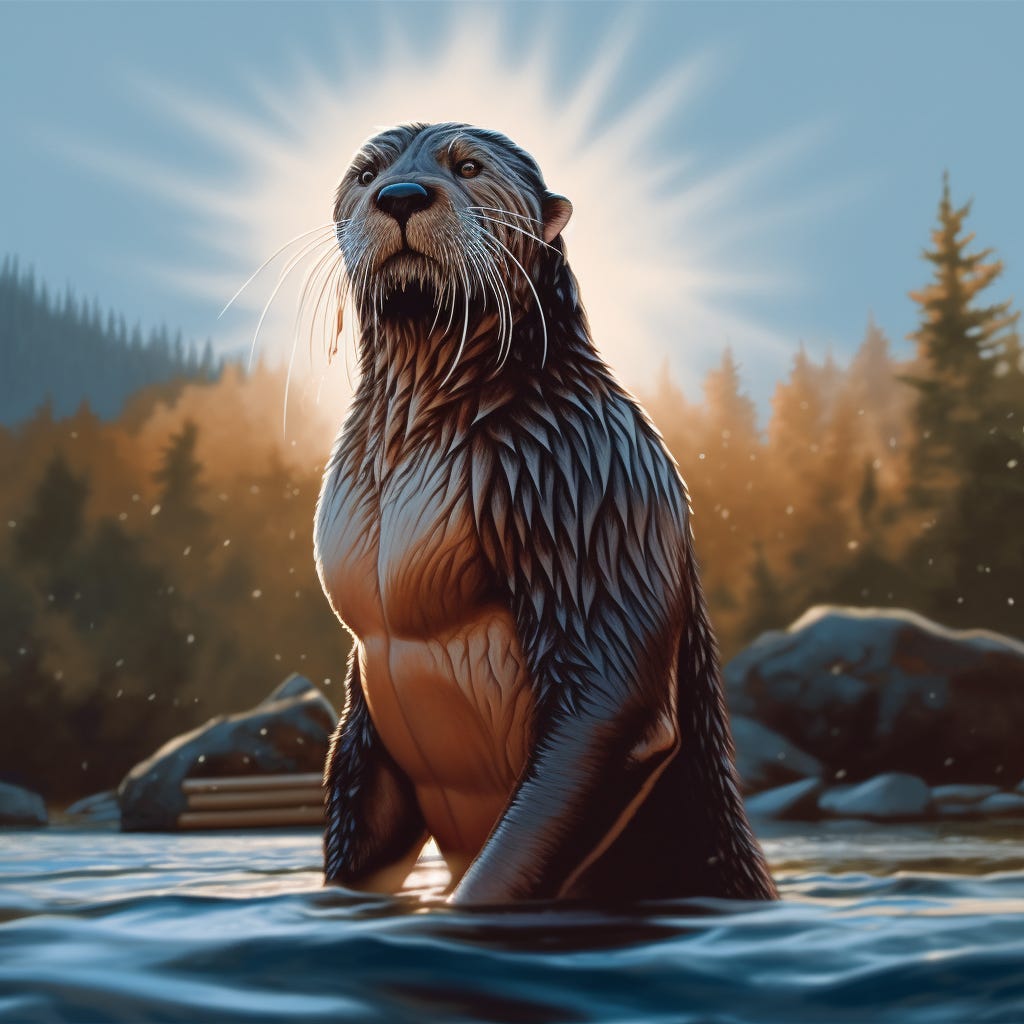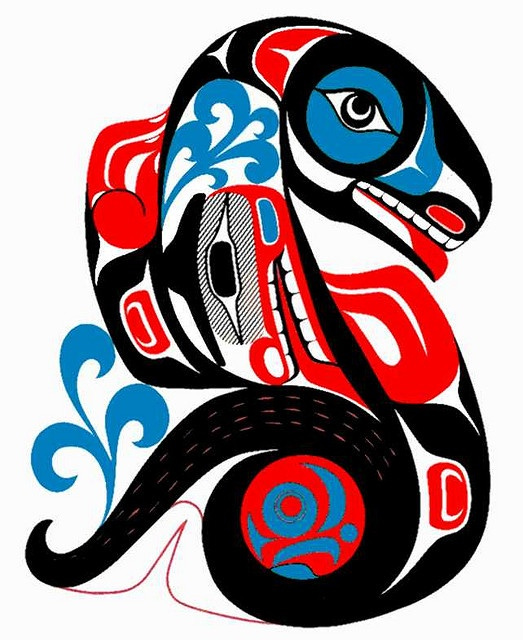You thought Bigfoot was the reigning champ of the cryptid world? Think again! Sorry, Bigfoot, but you might want to sit this one out. There’s another cryptid on the scene ready to steal the spotlight - one that’s mysterious, occasionally temperamental, and, oh, did I mention it’s a shapeshifter? Yes, you read that right. Meet the Kushtaka, also known as the Otterman, a creature steeped in Alaskan folklore.
The Enigmatic Kushtaka: A Cryptid Unlike Any Other
“Kushtaka” translates to “Land Otter Man,” but don’t be fooled by the seemingly harmless title. This is no ordinary otter lounging lazily on riverbanks. The Kushtaka is a trickster of the highest order, a creature capable of transforming its appearance, weaving illusions, and, if you’re unlucky, turning you into one of its own.
Originally from the Tlingit tribes of Southeast Alaska, particularly around Juneau and Sitka, the Kushtaka has been a central figure in local legends for generations. The stories vary, but one thing remains constant: the Kushtaka is not to be underestimated. Whether it’s luring sailors with fake distress signals or guiding lost souls to safety (at a cost), this cryptid plays a significant role in Tlingit culture.
The Kushtaka’s Shapeshifting Abilities
So, what exactly does the Kushtaka look like? According to folklore, it’s a hybrid of man and otter, often appearing in human form when it suits its purposes. It has an uncanny ability to shift between human and otter forms, and it can even project illusions of loved ones to comfort lost souls - though sometimes, this comfort comes at a price. If you’re not careful, you might be transformed into a Kushtaka.
Shapeshifting is the Kushtaka’s bread and butter. It’s not just about physical transformations; the Kushtaka can mimic voices, too. Imagine hearing the cry of a child or a woman’s scream in the distance, only to discover it’s an otter-human hybrid playing tricks on you. Spooky, right? And if you hear the creature’s signature triple-tone whistle - low-high-low - it’s said to be so eerie it can freeze you in place.
Friend or Foe? The Kushtaka’s Dual Nature
In the world of cryptids, the Kushtaka is unique for its dual nature. On the one hand, it’s portrayed as a villainous trickster, luring sailors and travelers to their doom with cries for help or mischievously leading them astray. Some legends even suggest that the Kushtaka is responsible for turning its victims into fellow Kushtaka, adding to their ranks with every successful encounter.
But the Kushtaka isn’t all bad. In some stories, it serves as a guardian, guiding lost individuals through the Alaskan wilderness and saving them from certain death. The catch? You may survive, but you could end up with a new identity as a member of the Otterman clan. For those who choose the otter life, it’s a small price to pay to stay alive in the unforgiving wilderness.
The Kushtaka’s Role in Tlingit Culture
Beyond its trickery and shapeshifting antics, the Kushtaka holds deep cultural significance for the Tlingit people. It symbolizes the delicate balance between land and sea, the harmony between nature and humanity, and the ever-present threat of the unknown. In many ways, the Kushtaka reminds us of nature’s power and the importance of respecting the natural world.
Tlingit stories about the Kushtaka aren’t just spooky campfire tales - they reflect the beliefs and values of a culture deeply connected to its environment. In these stories, the Kushtaka embodies the untamed forces of nature, serving as a metaphor for survival and the dangers lurking just beyond the familiar.
The Dark Side of the Kushtaka: Soul-Stealer & Trickster
For all its cultural significance, the Kushtaka also has a darker side. Some legends describe it as a soul-stealer capable of controlling the spirits of its victims. This aspect of the Kushtaka’s mythology makes it all the more terrifying - after all, it’s one thing to lose your way in the wilderness but another to lose your soul entirely.
These tales also depict the Kushtaka as a master of deception. Its ability to mimic voices and create illusions can lure unsuspecting travelers into dangerous situations, often leading to their demise. Some accounts even suggest that the Kushtaka use these abilities to manipulate entire groups of people, tricking them into thinking they’re being rescued, only to lead them into further peril.
Survival Tips: How to Avoid Becoming Kushtaka Bait
So, what should you do if you find yourself face-to-face with a Kushtaka? Luckily, there are a few survival tips passed down through generations that might save you from joining the Otterman Club.
First, don’t underestimate the power of copper. According to legend, the Kushtaka has a strong aversion to copper, so carrying a copper amulet or object could keep the shapeshifter at bay. Fire is another effective deterrent - build a blazing fire, and the Kushtaka won’t come near.
If you have a dog, consider yourself lucky. It’s said that Kushtaka can’t stand dogs, which makes your furry companion the perfect cryptid repellent. And in the absolute worst-case scenario, there’s always the option of… well, urinating. Kushtaka, like many wild animals, reportedly have a strong dislike for human urine, so marking your territory could be your last line of defense.
Kushtaka Sightings: Fact or Folklore?
While there haven’t been any scientifically confirmed Kushtaka sightings, the legends persist, and eyewitness accounts continue to trickle in. Some claim to have seen strange, otter-like creatures walking on two legs. Others report hearing the Kushtaka’s signature while echoing through the Alaskan wilderness. Whether these stories are the product of overactive imaginations or genuine encounters is up for debate, but one thing is clear: the legend of the Kushtaka is alive and well.


In recent years, the Kushtaka has even made its way into popular culture. From novels and comic books to TV shows and video games, the Otterman has captured the imagination of people around the world. Shows like Missing in Alaska and Alaska Monsters have featured the Kushtaka, adding fuel to the fire of its already-growing reputation.
Conclusion: The Kushtaka’s Enduring Legacy
Although the Kushtaka may not have the same name recognition as Bigfoot, it’s every bit as fascinating - and perhaps even more terrifying. As both a trickster and a protector, villain and a guide, the Kushtaka defies easy categorization. This complexity makes it such a compelling figure in cryptid lore.
Whether you believe the stories or not, there’s no denying the power of the Kushtaka legend. It’s a tale of survival, deception, and the thin line between life and death in the wilds of Alaska. So, the next time you find yourself trekking through the wilderness, keep an eye out for otters - they might be more than meets the eye.
Support Alaskan Native Communities
If you would like to support the Alaskan Native communities, here are some organizations that you can reach out to:
Alaska Native Heritage Center - https://www.alaskanative.net/
Sealaska Heritage Institute - https://www.sealaskaheritage.org/
Resources
Alaska Native Heritage Center - https://www.alaskanative.net/
Sealaska Heritage Institute - https://www.sealaskaheritage.org/
Alaska Native Knowledge Network - https://ankn.uaf.edu/
"Kushtaka: Native Tales from the Land of the Haida" by David Boxley
"Native American Animal Stories" by Joseph Bruchac
"Haida Gwaii: On the Edge of the World" documentary
"Kushtaka, Kwaan, Kasaan & Kaigani Haida: The Haida People of Alaska" documentary
"The Kushtaka, Alaska's Legendary Shape-Shifting Creature" by Jeff Rennicke - National Geographic (2016) - https://www.nationalgeographic.com/adventure/destinations/united-states/alaska/alaska-kushtaka-legendary-shape-shifting-creature/
"The Kushtaka: Alaska's 'Land Otter Man'" by Erin Allen - Smithsonian Magazine (2015) - https://www.smithsonianmag.com/travel/the-kushtaka-alaskas-land-otter-man-180954810/
"Kushtaka: The Mythical Alaskan Creature That Will Haunt Your Dreams" by Ellen Lloyd - AncientPages.com (2017) - https://www.ancientpages.com/2017/07/05/kushtaka-the-mythical-alaskan-creature-that-will-haunt-your-dreams/
Waller, D. (2014). In Search of the Kushtaka: Alaska’s Other Bigfoot the Land-Otter Man of the Tlingit Indians. CreateSpace. https://amzn.to/4gqTzRX
Waller, D. (2014). Otter Tales: Stories of the land otter man and other spirit stories based on the folklore of the Tlingit of Southeastern Alaska. CreateSpace Independent Publishing. https://amzn.to/47u7x1v
Wikimedia Foundation. (2023, March 15). Kushtaka. Wikipedia. https://en.wikipedia.org/wiki/Kushtaka
Cauldron, M. (2021). Kushtaka. Puzzle Box Horror. https://puzzleboxhorror.com/encyclopedia-of-supernatural-horror/kushtaka/
Team, D. &. V. (2022, July 1). BEWARE: Understand the Legend of Kushtaka Before Visiting Alaska. Drivin’ & Vibin’. https://drivinvibin.com/2022/07/12/kushtaka/
Brady, K. &. O. (2022, July 20). You’ve Heard of Bigfoot But Have You Heard of Kushtaka? HWY.CO. https://hwy.co/kushtaka/
Lynch, C. (2021, April 26). Creepy Cryptids: Kushtaka. The Morbid Library & Archive. https://themorbidlibrary.com/2021/04/25/creepy-cryptids-kushtaka/
Dabbah, A. (2013, January 9). The Fearsome Alaskan Tlingit Kushtaka: If it’s not One Thing, it’s an Otter. EsoterX. https://esoterx.com/2013/01/09/the-fearsome-alaskan-tlingit-kushtaka-if-its-not-one-thing-its-an-otter/
Barazzuol, Richard. “The Tlingit Land Otter Complex: Coherence in the Social and Shamanic Order”. Masters Thesis, Department of Anthropology, University of British Columbia, 1981.
Swanton, John Reed, 1873-1958. Tlingit Myths And Texts. Washington: Govt. print. off., 1909.
Paulin, S. (2022). Kushtaka: Alaska’s Shapeshifting Otter. PARANORMAL CATALOG. https://www.paranormalcatalog.net/cryptids/kushtaka-alaskas-shapeshifting-otter
Armstrong, C. (2023). This Alaska Legend Will Send Chills Down Your Spine. OnlyInYourState®. https://www.onlyinyourstate.com/alaska/kushtaka-land-otter-legend-ak/








